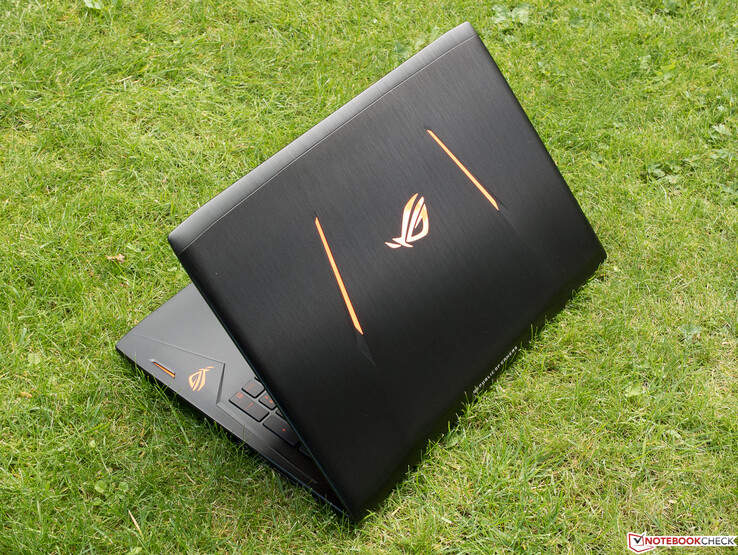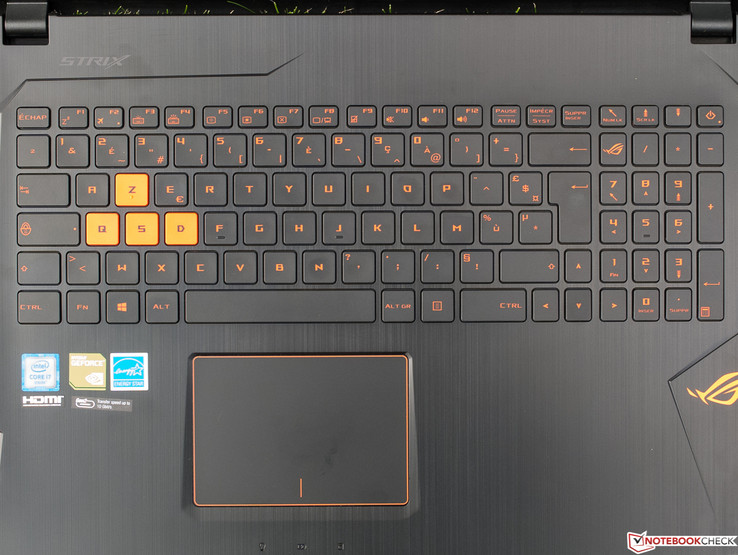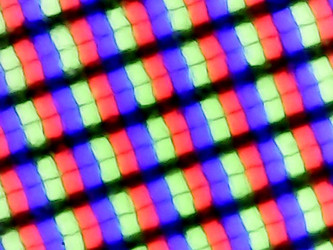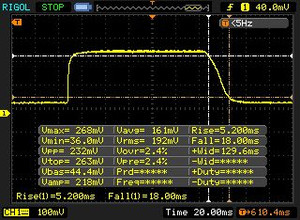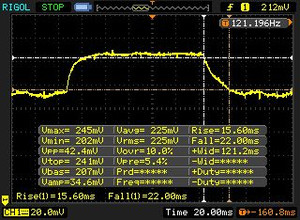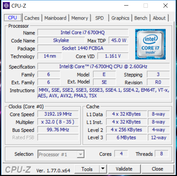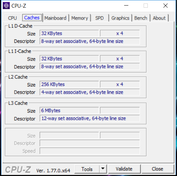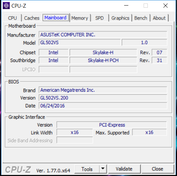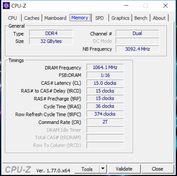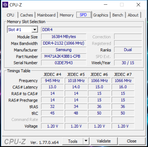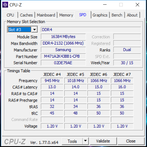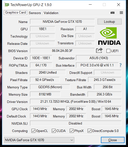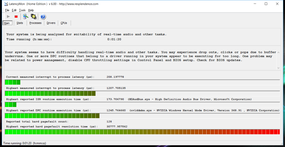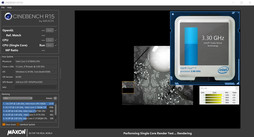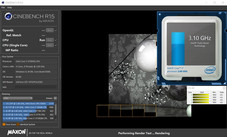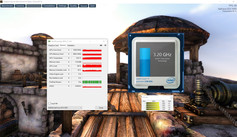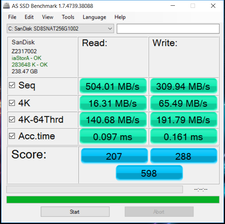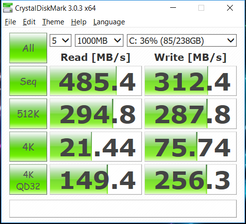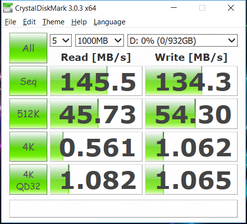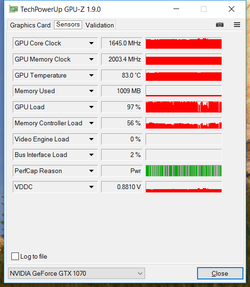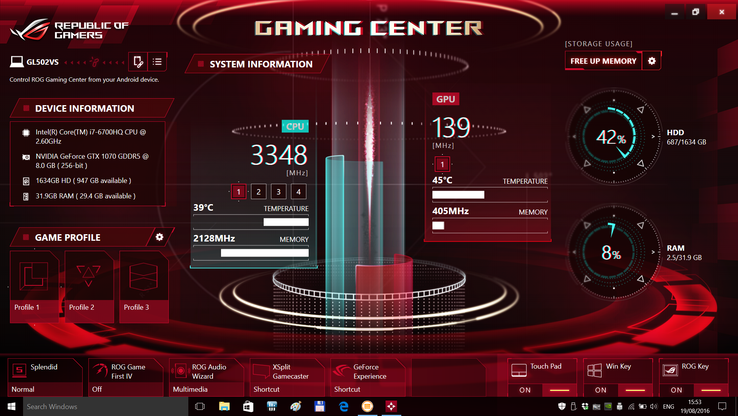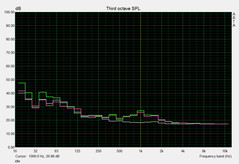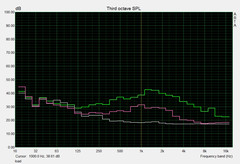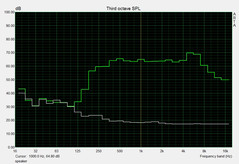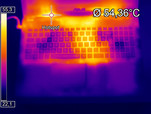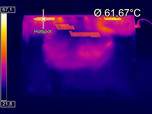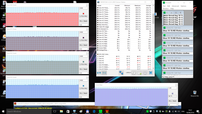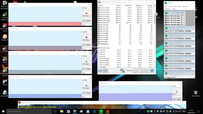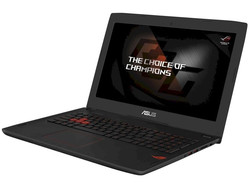Asus ROG Strix GL502VS Notebook Review

For the original German review, see here.
Besides Alienware, Schenker, and MSI, Asus is one of the most important players in the gaming segment with the futuristically looking ROG-series, which is specifically designed for gamers. We actually just reviewed the two Maxwell based predecessors Asus ROG Strix GL502VT (GTX 970M) and GL502VY (GTX 980M) in June and July, respectively. These 15-inch notebooks are still relatively portable and managed good scores of 82 and 83 percent in our reviews.
Our test model today is one of two Strix GL502 SKUs, more precisely the GL502VS. The other model has the designation GL502VM and is equipped with the significantly slower Pascal GPU GTX 1060. It is, however, 6.6 mm (~0.3 in) thinner as well as 100 grams (~3.5 oz) lighter in return, and is – contrary to the VS model – equipped with a Thunderbolt 3 port. Nvidia's Optimus technology, which saves power, was supported by the old GL502VT, but not the new models. They do support G-Sync though, which was formerly only the case for the GL502VY (no Optimus).
The Asus ROG Strix GL502VS is based on the 45-watt CPU Intel Core i7-6700HQ, which is a very popular choice for gaming notebooks. It is based on Intel's current Skylake architecture, has four native cores and supports Hyperthreading. The CPU is supported by 32 GB DDR4-RAM (dual-channel), and the video memory of the GTX 1070 (laptop) is quite future-proof at 8 GB GDDR5 as well. Storage space is provided by a SanDisk SSD with 256 GB in combination with a (pretty quick) conventional 1 TB hard drive. The IPS screen has 1920x1080 pixels and promises wide viewing angles. Besides the essential ports, the GL502VS also sports USB 3.1 Gen2, DisplayPort as well as HDMI 2.0 (!). Wireless connections (including the latest standards) are handled by an AC-module from Intel.
We use modern gaming notebooks from the formerly mentioned manufacturers and from our Top 10 Ranking as comparison devices. The two predecessors are obviously included in the tables as well. The rivals are:
- MSI GT62VR-6RE16H21 (GTX 1070)
- Acer Predator 15 G9-592-7925 (GTX 970M)
- Schenker XMG P506 PRO (GTX 980M)
- Asus ROG Strix GL502VT (GTX 970M)
- Asus ROG Strix GL502VY (GTX 980M)
Case
Since the chassis was not changed compared to the mentioned predecessors, we will keep it short in this section and focus on some additions and the quality evaluation. Both the aluminum lid and the plastic cover of the base unit have a brushed metal finish, which is very susceptible to fingerprints and not easy to clean. The thin lid does not leave a very sturdy impression despite the aluminum, but pressure on the other hand is not a big problem. You can easily open the lid with one hand and sudden movements will only result in minimal bouncing.
The build quality of our test model is flawless and can therefore meet the high price tag. There are no protruding edges or uneven gaps. The base will just slightly bend when you twist it. That the overall case does not appear to be very sturdy is a result of creaking sounds you can hear when the lid is open and you lift the system at the rear of the base unit. The latter can also be pushed in at some points.
Length and width of the GL502VS are identical to the predecessor, but the new model is now 6.6 millimeters (~0.3 in) thicker compared to the GL502VT. The Schenker XMG P506 with the GTX 980M is similar in this regard, but about 200 grams (~0.4 lb) heavier. Another 100 grams (~0.2 lb) heavier is the MSI GT62VR and it is also thicker at 40 mm (~1.6 in), but the length and the width are on par with the new Strix. The monster among the 15-inch systems in this comparison is the Acer Predator 15 with an unusual depth of 300 mm (~11.8 in) and it also weighs almost 1 kg (~2.2 lb) more than the test model.
Connectivity
Asus includes all modern ports, and the only thing you could miss is the Thunderbolt 3 port, which is reserved for the GL502VM. In return, you get DisplayPort and HDMI 2.0 to drive external 4K monitors at 60 Hz. besides three common USB 3.0 ports. There is also a USB Type-C with support for USB 3.1 Gen2 (SuperSpeed+) and a maximum transfer rate of 10 Gbps. Not perfect for the target group: The audio port is a combined jack, so conventional headsets cannot be attached.
Asus managed to keep the front areas free of ports, so users of an external mouse should not have problems with colliding cables or attached peripherals. Very wide USB thumb drives or cables could block each other, but we did not have any issues.
SD Card Reader
You can expect transfer rates between 60 and 90 MB/s (JPG copy test) from modern notebooks, and all the comparison devices are within this range. Only the brand-new MSI GT62VR is much faster and reaches an impressive 190 MB/s when it copies a 1 GB file.
| SD Card Reader | |
| average JPG Copy Test (av. of 3 runs) | |
| MSI GT62VR-6RE16H21 | |
| Acer Predator 15 G9-592-7925 | |
| Schenker XMG P506 PRO | |
| Asus Strix GL502VS-FY032T | |
| maximum AS SSD Seq Read Test (1GB) | |
| MSI GT62VR-6RE16H21 | |
| Acer Predator 15 G9-592-7925 | |
| Schenker XMG P506 PRO | |
| Asus Strix GL502VS-FY032T | |
Communication
Gamers often avoid WLAN and use wired LAN connections, so the foldout Gigabit Ethernet port is basically crucial. The wireless capabilities are still very good since Asus equipped the test model with the current Dual-Band Wireless-AC 8260 (MIMO 2x2) from Intel. The maximum transfer rate in AC mode, which is only available in the wider and less crowded 5 GHz band, is up to 867 Mbps.
Under perfect conditions (1m/3 ft from the router), we determined very good 648 Mbps (receive) and 468 Mbps (send), respectively. Our standardized WLAN test is still rather new, so we can only compare the results with the MSI, which manages a 19% higher send rate. Intel's Wireless Display is also available, just like Bluetooth 4.1. It seems that some SKUs are equipped with the module Azwave/Lite-on 802.11bgn Wi-Fi + Bluetooth 4.0.
| Networking | |
| iperf Server (receive) TCP 1 m | |
| Asus Strix GL502VS-FY032T | |
| MSI GT62VR-6RE16H21 | |
| iperf Client (transmit) TCP 1 m | |
| MSI GT62VR-6RE16H21 | |
| Asus Strix GL502VS-FY032T | |
Accessories
Maybe we should finally stop expecting noteworthy accessories for gaming notebooks. Asus only puts the usual cable ties in the box besides the power adapter and the service brochures. You can see an overview about numerous additional accessories for the ROG notebooks here.
Maintenance
Considering the increased cooling requirements, gaming systems move a lot of air around and dust should be removed from time to time. Similar to the predecessors, Ten screws must be removed from the bottom panel before you can access the internals. This includes the fans and all other important components, although both the CPU and GPU are soldered.
The memory slots deserve criticism since there are only two of them. Still, we do not expect 32 GB RAM to be the limiting factor anytime soon before the whole system is outdated. This should still take a couple of years when you consider the enormous performance and the modern features.
Warranty
Asus grants a two-year manufacturer's warranty and there do not seem to be any extensions.
Input Devices
Keyboard
Most of the keys have a slightly concave shape and all of them have a non-slip surface. They are black and follow the overall design with orange lettering, but contrast is lacking when the three-stage red illumination is activated. Our review sample features a French layout, so we cannot say much in this respect. Macro keys are missing, but you get some auxiliary keys to launch the ROG Gaming Center, for example. It seems Asus wants to keep the smaller number pad, which is tricky to use for bigger hands. As always, this does result in a small point deduction in this section.
Similar to the majority of gaming notebooks, the keys have about 1.5 mm travel. We would not call the pressure point crisp, but it is easy to feel and conveniently far away from the rather soft sprung stroke. While many smaller keys are quiet, some of the bigger keys clatter a bit, which limits the usability in noise-sensitive environments. The keyboard, which is identical to the predecessors, is very stable and leaves a solid impression. We liked it and managed comparatively high typing speeds.
Touchpad
The mouse replacement is a ClickPad with integrated buttons, but they are not visibly separated. The pad is slightly depressed and sufficiently sized, but does not accept inputs in the peripheral areas. We had some issues with the smooth surface. The feedback is a bit soft, but the main problem is (especially in the summer) the gliding capabilities. Moist fingers will often stutter, but there are no problems with dry fingers. Precision and response are – similar to the predecessors – very good, and even fast movements are captured correctly.
The two mouse buttons offer good audible and tactile feedback thanks to the firm pressure point. Gestures are recognized with up to three fingers and can be adjusted in the Windows settings, but we did not find a dedicated driver panel offering additional settings.
Display
The Full HD display is based on IPS technology and has a matte surface. Its maximum luminance is sufficient for outdoor environments. The measured brightness distribution is acceptable. Besides the high luminance, the good contrast (984:1) also benefits from the low black value. We can measure 0.35 cd/m² for the Asus Strix.
The color deviations ex-works are actually not that bad for an IPS screen at around 4.5, while the ideal value would be smaller 3 (DeltaE). A calibration did not really improve the ColorChecker results, while the grayscale improved to an excellent value of 0.87 (average). We did not notice a color cast ex-works, but the GL502VS is still not a good choice for serious picture editing. Even the small sRGB color space is only covered by 83 percent.
We could not notice PWM, but the slow response times might be a problem for professional gamers. The results are still common for an IPS screen.
| |||||||||||||||||||||||||
Brightness Distribution: 85 %
Center on Battery: 315 cd/m²
Contrast: 984:1 (Black: 0.32 cd/m²)
ΔE ColorChecker Calman: 4.88 | ∀{0.5-29.43 Ø4.77}
ΔE Greyscale Calman: 4.17 | ∀{0.09-98 Ø5}
83% sRGB (Argyll 1.6.3 3D)
55% AdobeRGB 1998 (Argyll 1.6.3 3D)
60.8% AdobeRGB 1998 (Argyll 3D)
83.1% sRGB (Argyll 3D)
64.5% Display P3 (Argyll 3D)
Gamma: 2.53
CCT: 6683 K
| Asus Strix GL502VS-FY032T LG Philips LP156WF6-SPB6 (LGD046F), , 1920x1080, 15.6" | MSI GT62VR-6RE16H21 LG Philips LP156WF6 (LGD046F), , 1920x1080, 15.6" | Acer Predator 15 G9-592-7925 LG Philips LP156WF6-SPP1 (LGD04D5), , 1920x1080, 15.6" | Schenker XMG P506 PRO LG Philips LP156WF6 (LGD046F), , 1920x1080, 15.6" | Asus Strix GL502VT-DS74 1920x1080, 15.6" | Asus Strix GL502VY-DS71 1920x1080, 15.6" | |
|---|---|---|---|---|---|---|
| Display | 1% | -1% | 1% | 11% | 0% | |
| Display P3 Coverage (%) | 64.5 | 64.6 0% | 63 -2% | 65.1 1% | 66.7 3% | 63 -2% |
| sRGB Coverage (%) | 83.1 | 84.6 2% | 82.2 -1% | 83.7 1% | 97.7 18% | 84.3 1% |
| AdobeRGB 1998 Coverage (%) | 60.8 | 61.8 2% | 60.1 -1% | 61.2 1% | 68.4 13% | 61.6 1% |
| Response Times | 8% | -9% | -3% | -65% | 3% | |
| Response Time Grey 50% / Grey 80% * (ms) | 38 ? | 34 ? 11% | 43 ? -13% | 37 ? 3% | 56.4 ? -48% | 32 ? 16% |
| Response Time Black / White * (ms) | 23 ? | 22 ? 4% | 24 ? -4% | 25 ? -9% | 41.6 ? -81% | 25.6 ? -11% |
| PWM Frequency (Hz) | 201.6 ? | |||||
| Screen | 7% | -5% | 4% | -9% | 3% | |
| Brightness middle (cd/m²) | 315 | 273 -13% | 302 -4% | 312 -1% | 296.8 -6% | 347.2 10% |
| Brightness (cd/m²) | 290 | 278 -4% | 287 -1% | 293 1% | 282 -3% | 327 13% |
| Brightness Distribution (%) | 85 | 88 4% | 91 7% | 87 2% | 86 1% | 88 4% |
| Black Level * (cd/m²) | 0.32 | 0.27 16% | 0.36 -13% | 0.32 -0% | 0.347 -8% | 0.348 -9% |
| Contrast (:1) | 984 | 1011 3% | 839 -15% | 975 -1% | 855 -13% | 998 1% |
| Colorchecker dE 2000 * | 4.88 | 3.67 25% | 4.93 -1% | 4.45 9% | 5.24 -7% | 4.53 7% |
| Colorchecker dE 2000 max. * | 8.88 | 8.33 6% | 12.34 -39% | 8.5 4% | 11.36 -28% | 11.01 -24% |
| Greyscale dE 2000 * | 4.17 | 2.73 35% | 3.47 17% | 3.05 27% | 6.76 -62% | 2.84 32% |
| Gamma | 2.53 87% | 2.49 88% | 2.16 102% | 2.58 85% | 2.24 98% | 2.05 107% |
| CCT | 6683 97% | 7029 92% | 6622 98% | 6495 100% | 8467 77% | 6664 98% |
| Color Space (Percent of AdobeRGB 1998) (%) | 55 | 55 0% | 54 -2% | 55 0% | 62.8 14% | 54.7 -1% |
| Color Space (Percent of sRGB) (%) | 83 | 84 1% | 82 -1% | 84 1% | 98.1 18% | 84.1 1% |
| Total Average (Program / Settings) | 5% /
6% | -5% /
-5% | 1% /
3% | -21% /
-13% | 2% /
3% |
* ... smaller is better
Even though the notebook was definitely designed to be used indoors, you can also use it pretty well outdoors. It should not be a problem to find a spot where you can see the display content without any big limitations, even on sunny days. The screen is only overpowered by direct sunlight.
IPS panels like the one in the test model promise much wider viewing angles compared to TN screens. You still have to expect a brightness and contrast drop the wider the angle gets. If you view the screen from above, for example, there can be slight color deviations, but our pictures exaggerate the problem a bit. Overall, the performance is average for an IPS panel.
Display Response Times
| ↔ Response Time Black to White | ||
|---|---|---|
| 23 ms ... rise ↗ and fall ↘ combined | ↗ 5 ms rise | |
| ↘ 18 ms fall | ||
| The screen shows good response rates in our tests, but may be too slow for competitive gamers. In comparison, all tested devices range from 0.1 (minimum) to 240 (maximum) ms. » 51 % of all devices are better. This means that the measured response time is worse than the average of all tested devices (20.2 ms). | ||
| ↔ Response Time 50% Grey to 80% Grey | ||
| 38 ms ... rise ↗ and fall ↘ combined | ↗ 16 ms rise | |
| ↘ 22 ms fall | ||
| The screen shows slow response rates in our tests and will be unsatisfactory for gamers. In comparison, all tested devices range from 0.165 (minimum) to 636 (maximum) ms. » 54 % of all devices are better. This means that the measured response time is worse than the average of all tested devices (31.6 ms). | ||
Screen Flickering / PWM (Pulse-Width Modulation)
| Screen flickering / PWM not detected | ||
In comparison: 53 % of all tested devices do not use PWM to dim the display. If PWM was detected, an average of 8088 (minimum: 5 - maximum: 343500) Hz was measured. | ||
Performance
A notebook that can handle even the most demanding games without any problems is also powerful enough for any other usage scenario. Similar to the sibling GL502VM (GTX 1060), the GL502VS supports G-Sync and is VR-ready.
Processor
It is not surprising to see the Skylake processor Intel Core i7-6700HQ in numerous high-end gaming systems. The majority of GPU demanding titles often benefits from four physical cores, which can execute up to eight tasks simultaneously thanks to Hyperthreading. They have a nominal clock of 2.6 GHz and can reach up to 3.5 GHz (4 cores: 3.1 GHz, 2 cores: 3.3 GHz) via Turbo Boost. The chip in our review unit delivers the expected Cinebench R15 results. Only the slightly higher clocked and tunable i7-6820HK of the Schenker XMG P506 Pro is a bit faster.
If the notebook is powered by a modern high-end GPU like the GTX 1070, you should expect an FPS limitation even in higher settings when you only use a dual-core with Hyperthreading. Skylake supports DDR4-RAM for the first time, and Asus uses it to increase the performance. Notebooks with such a quad-core need bigger cases due to the higher TDP of 45 watts, and the limit should be 15.6 or 14-inch models. CPUs like the i7-6700HQ have absolutely no problems even with the most demanding games, so you do not have to worry about other applications, either.
System Performance
The Strix GL502VS is one of the fastest notebooks in our database. There are numerous devices with higher scores, but the performance advantage in PCMark 8 (Home) is rarely more than 10%. Even better is the brand-new Asus G752VS-XB78K, which is also equipped with a GTX 1070. Still, +20% should not have a big impact in practice, because the system already feels very fast, and it is hard to imagine another improvement considering the smooth handling even with excessive multi-tasking as well as fast application and OS launches.
| PCMark 8 | |
| Home Score Accelerated v2 | |
| Asus Strix GL502VS-FY032T | |
| MSI GT62VR-6RE16H21 | |
| Asus Strix GL502VY-DS71 | |
| Asus Strix GL502VT-DS74 | |
| Work Score Accelerated v2 | |
| Asus Strix GL502VS-FY032T | |
| MSI GT62VR-6RE16H21 | |
| Asus Strix GL502VY-DS71 | |
| Asus Strix GL502VT-DS74 | |
| PCMark 8 Home Score Accelerated v2 | 4651 points | |
| PCMark 8 Work Score Accelerated v2 | 5011 points | |
Help | ||
Storage Devices
If you want to criticize a bit on a high level, you could say that the M.2-SSD from SanDisk is only attached via SATA-III and is therefore not one of the fastest models. Sequential read transfer rates are limited to around 500 MB/s by the interface, so loading times of bigger gaming files can be slightly longer compared to the fast NVMe-SSD in the Schenker system.
The 4K read results, which are important for application launches, are pretty slow where we would have expected at least 20 MB/s. The SSDs from the rivals are generally faster in many of all tests, but you will have a hard time to notice that in practice. The excellent PCMark results speak for themselves.
| Asus Strix GL502VS-FY032T SanDisk SD8SNAT256G1002 | MSI GT62VR-6RE16H21 Toshiba HG6 THNSNJ256G8NY | Acer Predator 15 G9-592-7925 Samsung SSD PM871 MZNLN512HCJH | Schenker XMG P506 PRO Samsung SSD 950 Pro 512GB m.2 NVMe | Asus Strix GL502VT-DS74 Lite-On CV1-8B128 | Asus Strix GL502VY-DS71 SanDisk SD8SN8U1T001122 | |
|---|---|---|---|---|---|---|
| CrystalDiskMark 3.0 | 39% | 48% | 223% | 7% | 26% | |
| Read Seq (MB/s) | 485.4 | 523 8% | 510 5% | 2249 363% | 494.5 2% | 496.8 2% |
| Write Seq (MB/s) | 312.4 | 485.5 55% | 455.3 46% | 1331 326% | 184.1 -41% | 454.8 46% |
| Read 512 (MB/s) | 294.8 | 444.7 51% | 415.9 41% | 972 230% | 318.6 8% | 281.1 -5% |
| Write 512 (MB/s) | 287.8 | 471.2 64% | 422.3 47% | 732 154% | 182.6 -37% | 400 39% |
| Read 4k (MB/s) | 21.44 | 21.86 2% | 32.46 51% | 54.6 155% | 30.04 40% | 26.43 23% |
| Write 4k (MB/s) | 75.7 | 98.8 31% | 92.5 22% | 173 129% | 77.2 2% | 50.2 -34% |
| Read 4k QD32 (MB/s) | 149.4 | 350.3 134% | 358.6 140% | 687 360% | 312.6 109% | 347.8 133% |
| Write 4k QD32 (MB/s) | 256.3 | 162.2 -37% | 329.1 28% | 418.5 63% | 182.1 -29% | 263.1 3% |
GPU Performance
Brand-new, very fast, efficient, and expensive; these are the keywords that come to mind for the new Pascal GPUs from Nvidia. The GeForce GTX 1070 is obviously the highlight of the GL502VS. The recently announced GPU has 8 GB GDDR5-VRAM and a 256-bit memory interface for longer legs down the road.
The chip should not have performance problems anytime soon, either; the performance reserves are just too big. GPU-Z shows a nominal clock of 1443 MHz. The slightly higher clocked desktop version of the GTX 1070 has 1920 shaders, while the mobile version gets 2048. Compared to the direct predecessor GeForce GTX 970M, the 3D performance was more than doubled, while the power consumption is just slightly higher. Nvidia really did a good job. The times when hardcore gamers only used desktop PCs should finally be over with Pascal. More information about the new GPU architecture is available in our dedicated article.
The picture below shows the ROG Gaming Center, which can also be operated via an Android app. You can see system information, CPU and GPU clocks, create gaming profiles, adjust the color scheme of the display and clean up the memory. You can also activate/deactivate touchpad, Windows key and the dedicated ROG key. Finally, there are some useful shortcuts at the bottom left for the ROG Audio Wizard, for example.
We used the Unigine Heaven benchmark to observe the clocks of the GPU. The lowest core clock was 1582 MHz, the highest 1771 MHz. These two extreme values are limited to very brief moments, and the clock was usually fluctuating around 1620 MHz with a maximum temperature of 83 °C (181.4 °F). The performance is heavily limited on battery power. The overall 3DMark 11 score dropped from 15,822 to just 6753 without a socket (-57%).
| 3DMark 11 - 1280x720 Performance GPU | |
| MSI GT62VR-6RE16H21 | |
| Asus Strix GL502VS-FY032T | |
| Schenker XMG P506 PRO | |
| Asus Strix GL502VY-DS71 | |
| Acer Predator 15 G9-592-7925 | |
| Asus Strix GL502VT-DS74 | |
| 3DMark - 1920x1080 Fire Strike Graphics | |
| MSI GT62VR-6RE16H21 | |
| Asus Strix GL502VS-FY032T | |
| Schenker XMG P506 PRO | |
| Asus Strix GL502VY-DS71 | |
| Acer Predator 15 G9-592-7925 | |
| Asus Strix GL502VT-DS74 | |
| 3DMark 11 Performance | 15822 points | |
| 3DMark Cloud Gate Standard Score | 22943 points | |
| 3DMark Fire Strike Score | 12909 points | |
Help | ||
Gaming Performance
One of the few titles where the Maxwell predecessors GTX 970M and GTX 980 struggled at the highest settings was the great looking, but very demanding, Assassin's Creed Syndicate. Even such a title is no problem for the GTX 1070.
Compared to rivals with the GeForce GTX 980M, the GL502VS manages 70 and 80 percent higher scores in the two 3DMarks. The modern and great looking Rise of the Tomb Raider (Very High) runs 61 percent faster, and Doom (Ultra) even 123 percent faster. There is currently no new game that would not run smoothly on the Strix with the highest settings and activated picture improvements like anti-aliasing and ambient occlusion (SSAO, HBAO+). The MSI GT62VR notebook, which is also equipped with the GTX 1070, is sometimes a bit faster and sometimes slower. We did use the driver version 372.53 for our tests.
| Rise of the Tomb Raider | |
| 1920x1080 Very High Preset AA:FX AF:16x | |
| Asus Strix GL502VS-FY032T | |
| MSI GT62VR-6RE16H21 | |
| Asus Strix GL502VY-DS71 | |
| Asus Strix GL502VT-DS74 | |
| 1920x1080 High Preset AA:FX AF:4x | |
| Asus Strix GL502VS-FY032T | |
| MSI GT62VR-6RE16H21 | |
| Asus Strix GL502VY-DS71 | |
| Asus Strix GL502VT-DS74 | |
| Battlefield 4 - 1920x1080 Ultra Preset AA:4x MS | |
| MSI GT62VR-6RE16H21 | |
| Asus Strix GL502VS-FY032T | |
| The Witcher 3 | |
| 1920x1080 Ultra Graphics & Postprocessing (HBAO+) | |
| MSI GT62VR-6RE16H21 | |
| Asus Strix GL502VS-FY032T | |
| 1920x1080 High Graphics & Postprocessing (Nvidia HairWorks Off) | |
| MSI GT62VR-6RE16H21 | |
| Asus Strix GL502VS-FY032T | |
| Doom | |
| 1920x1080 Ultra Preset AA:SM | |
| Asus Strix GL502VS-FY032T | |
| MSI GT62VR-6RE16H21 | |
| Asus Strix GL502VY-DS71 | |
| 1920x1080 High Preset AA:FX | |
| Asus Strix GL502VS-FY032T | |
| MSI GT62VR-6RE16H21 | |
| Asus Strix GL502VY-DS71 | |
| Mirror's Edge Catalyst | |
| 1920x1080 Ultra Preset AF:16x | |
| MSI GT62VR-6RE16H21 | |
| Asus Strix GL502VS-FY032T | |
| 1920x1080 High Preset AF:16x | |
| MSI GT62VR-6RE16H21 | |
| Asus Strix GL502VS-FY032T | |
| low | med. | high | ultra | |
|---|---|---|---|---|
| Battlefield 4 (2013) | 192.2 | 132.7 | ||
| The Witcher 3 (2015) | 165.9 | 102.4 | 55.2 | |
| Rise of the Tomb Raider (2016) | 104 | 88.7 | ||
| Doom (2016) | 130.1 | 125.1 | ||
| Mirror's Edge Catalyst (2016) | 99.6 | 92 |
Emissions
System Noise
We did include a picture of the opened chassis in the gallery above, where you can see that the cooling system did not really change. Similar to the GL502VT, for instance, we once again get two 50-mm fans, which are connected to the CPU, GPU, and VRAM via copper heat pipes.
We collected our subjective impression in a quiet single office with the running PC. While the CPU fan is never deactivated, it is hard to hear from a typical distance of about half a meter (~1.5 ft) while idling. The base fan speed is sufficient for office applications or web browsing. Short peak load, which is typical for these scenarios, is handled by the passive cooling capabilities, so there is no annoying pulsating. These passive cooling capabilities are also supported by our stress test (Prime95 + FurMark), where the fans slowly started to increase their speed seamlessly after a delay. They did keep spinning for a while after the test.
It gets pretty loud when the two fans reach their maximum speed. Besides a distinct murmur, we also heard a high-pitched sound, but it was not dominating. It could be annoying for younger users in particular. We did not reach the stress test volume when we played The Witcher 3, but the GL502VS is still not a quiet device during gaming by any means. We recommend the use of headphones. It is, however, subjective whether the noise is annoying (stress test) or tolerable (games).
Noise level
| Idle |
| 32 / 33 / 34 dB(A) |
| Load |
| 39 / 51 dB(A) |
 | ||
30 dB silent 40 dB(A) audible 50 dB(A) loud |
||
min: | ||
Temperature
You have to expect up to 47 °C (116.6 °F) at the bottom of the system if you want to play 3D games with the notebook on your lap, which is not very comfortable. The coolest area at the top is the palm rest, which does not surpass 32 °C (89.6 °F) in any situation. We did not have any problems with the surface temperatures in practice.
Our stress test screenshot shows that the processor clock leveled off at 2.8 GHz under sustained load, and there can be slight changes in both directions from time to time. Intel specifies the base clock of the Core i7-6700HQ with 2.6 GHz and a maximum Turbo of 3.1 GHz for 4 cores, so there is no throttling even in this impractical stress test scenario, but the utilization is not perfect, either. A core temperature of 92 °C (197.6 °F) is still within the specification.
(-) The maximum temperature on the upper side is 48 °C / 118 F, compared to the average of 40.4 °C / 105 F, ranging from 21.2 to 68.8 °C for the class Gaming.
(-) The bottom heats up to a maximum of 46.8 °C / 116 F, compared to the average of 43.3 °C / 110 F
(+) In idle usage, the average temperature for the upper side is 29 °C / 84 F, compared to the device average of 33.9 °C / 93 F.
(+) The palmrests and touchpad are cooler than skin temperature with a maximum of 30.6 °C / 87.1 F and are therefore cool to the touch.
(±) The average temperature of the palmrest area of similar devices was 28.8 °C / 83.8 F (-1.8 °C / -3.3 F).
Speakers
The speakers are located at the left and right side of the palm rest and have enough power to fill small and medium-sized rooms with sound. There are no distortions or volume fluctuations even when you crank it up. Even though you cannot speak about real bass due to the limited volume, they are fairly well emulated via psychoacoustic effects. The sound system manages to create a certain dynamic and even a hint of a spatial effect ex-works. The sound puts emphasis on the medium tones, but it is generally well balanced and appears rich as well as natural. The differentiation suffers a bit when you listen to metal music with many low-frequency instruments and drums, but the result is not completely blurred. The solid impression of the 2.0 system (for a notebook) is supported when you play games.
Asus Strix GL502VS-FY032T audio analysis
(±) | speaker loudness is average but good (77 dB)
Bass 100 - 315 Hz
(-) | nearly no bass - on average 16.2% lower than median
(±) | linearity of bass is average (11.9% delta to prev. frequency)
Mids 400 - 2000 Hz
(+) | balanced mids - only 0.7% away from median
(+) | mids are linear (3.1% delta to prev. frequency)
Highs 2 - 16 kHz
(+) | balanced highs - only 3.5% away from median
(±) | linearity of highs is average (7.4% delta to prev. frequency)
Overall 100 - 16.000 Hz
(±) | linearity of overall sound is average (16.8% difference to median)
Compared to same class
» 44% of all tested devices in this class were better, 11% similar, 46% worse
» The best had a delta of 6%, average was 18%, worst was 132%
Compared to all devices tested
» 29% of all tested devices were better, 7% similar, 64% worse
» The best had a delta of 4%, average was 24%, worst was 134%
MSI GT62VR-6RE16H21 audio analysis
(±) | speaker loudness is average but good (79 dB)
Bass 100 - 315 Hz
(±) | reduced bass - on average 11.3% lower than median
(±) | linearity of bass is average (11.4% delta to prev. frequency)
Mids 400 - 2000 Hz
(±) | higher mids - on average 8.3% higher than median
(+) | mids are linear (5.7% delta to prev. frequency)
Highs 2 - 16 kHz
(+) | balanced highs - only 4.3% away from median
(±) | linearity of highs is average (11% delta to prev. frequency)
Overall 100 - 16.000 Hz
(±) | linearity of overall sound is average (20.5% difference to median)
Compared to same class
» 73% of all tested devices in this class were better, 5% similar, 22% worse
» The best had a delta of 6%, average was 18%, worst was 132%
Compared to all devices tested
» 54% of all tested devices were better, 8% similar, 39% worse
» The best had a delta of 4%, average was 24%, worst was 134%
Frequency Comparison (Checkboxes select/deselectable!)
Graph 1: Pink Noise 100% Vol.; Graph 2: Audio off
Energy Management
Power Consumption
We start by comparing the power consumption of the test model with its predecessor Asus Strix GL502VY, which reaches very similar values with the GTX 980M. The only noticeable difference is in the average load measurement, which is important for gaming, where the new GL502VS consumes almost 50% less power than the VY. Notebooks with the GTX 970M are more frugal in general, but the average load value of the Asus is once again a bit lower. The predecessor GL502VT benefits from Nvidia's Optimus technology in the idle measurements. We can still say that the test model is agreeably frugal considering the massively improved 3D performance.
| Asus Strix GL502VS-FY032T GeForce GTX 1070 Mobile, 6700HQ | MSI GT62VR-6RE16H21 GeForce GTX 1070 Mobile, 6700HQ | Acer Predator 15 G9-592-7925 GeForce GTX 970M, 6700HQ | Schenker XMG P506 PRO GeForce GTX 980M, 6820HK | Asus Strix GL502VT-DS74 GeForce GTX 970M, 6700HQ | Asus Strix GL502VY-DS71 GeForce GTX 980M, 6700HQ | |
|---|---|---|---|---|---|---|
| Power Consumption | -9% | 19% | 4% | 25% | -4% | |
| Idle Minimum * (Watt) | 20 | 20 -0% | 12 40% | 15 25% | 11.1 44% | 20.6 -3% |
| Idle Average * (Watt) | 24 | 26 -8% | 16 33% | 20 17% | 14.1 41% | 22.1 8% |
| Idle Maximum * (Watt) | 29 | 32 -10% | 22 24% | 27 7% | 18.4 37% | 22.5 22% |
| Load Average * (Watt) | 86 | 100 -16% | 96 -12% | 98 -14% | 96.5 -12% | 130.6 -52% |
| Load Maximum * (Watt) | 183 | 202 -10% | 166 9% | 210 -15% | 159.5 13% | 177.2 3% |
* ... smaller is better
| Off / Standby | |
| Idle | |
| Load |
|
Key:
min: | |
Battery Runtime
Because of the performance drop on battery power, it is not very likely that demanding games will be played without the power adapter. We therefore focus on the realistic WLAN test at an adjusted luminance (how we test). The resulting runtime suffers heavily from the lack of Nvidia's Optimus graphics switching, which would use the CPU graphics Intel HD Graphics 530 for simple 2D applications. Without Optimus, the GTX 1070 handles them and is obviously not as power efficient as the integrated adapter.
Notebooks with the GeForce GTX 970M and Optimus support last much longer. The MSI GT62VR (75 Wh) has a bigger battery capacity than the review unit at 62 Wh and can use this advantage to manage longer runtimes.
| Asus Strix GL502VS-FY032T 62 Wh | MSI GT62VR-6RE16H21 75.24 Wh | Acer Predator 15 G9-592-7925 Wh | Schenker XMG P506 PRO 60 Wh | Asus Strix GL502VT-DS74 64 Wh | Asus Strix GL502VY-DS71 64 Wh | |
|---|---|---|---|---|---|---|
| Battery runtime | ||||||
| WiFi v1.3 (h) | 3.3 | 4.1 24% | 7.9 139% | 4.5 36% | 5.9 79% | 3.1 -6% |
Pros
Cons
Verdict
Asus' new ROG Strix GL502VS left a convincing impression in general. One main aspect is the enormous performance of the Nvidia GeForce GTX 1070. Gamers that are not too noise-sensitive should be very happy with the device.
We already mentioned in the teaser that there are also some drawbacks. The creaking chassis could leave a better impression, but the test model is from one of the first batches, so newer models could be better in this respect. We are not perfectly happy with the gliding capabilities of the touchpad and the limited color gamut of the otherwise very good IPS display, either. The response times of the screen might be too slow for some gamers as well. The perfect visibility of the keys was sacrificed for the design. Unusual, but not really important with 32 GB DDR4-RAM: There are only two SODIMM slots. 15-inch devices with this kind of performance cannot be cooled without any noise and the rivals might not be quieter, either – but it was often still a bit too loud in our opinion.
There is much more on the positive side of things: The comparatively lightweight case looks nice and should meet the design expectations of ROG customers. Asus also deserves praise for the generous and modern port selection. Nobody will criticize the comprehensive maintainability. The performance is on the expected level as well, so the technical specifications are okay. The good impression is rounded off with a good keyboard and a mostly convincing display. We can therefore recommend the system with the mentioned limitations.
Asus Strix GL502VS-FY032T
- 08/21/2016 v5.1 (old)
Sven Kloevekorn




